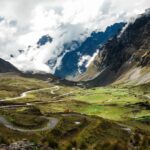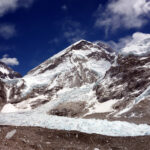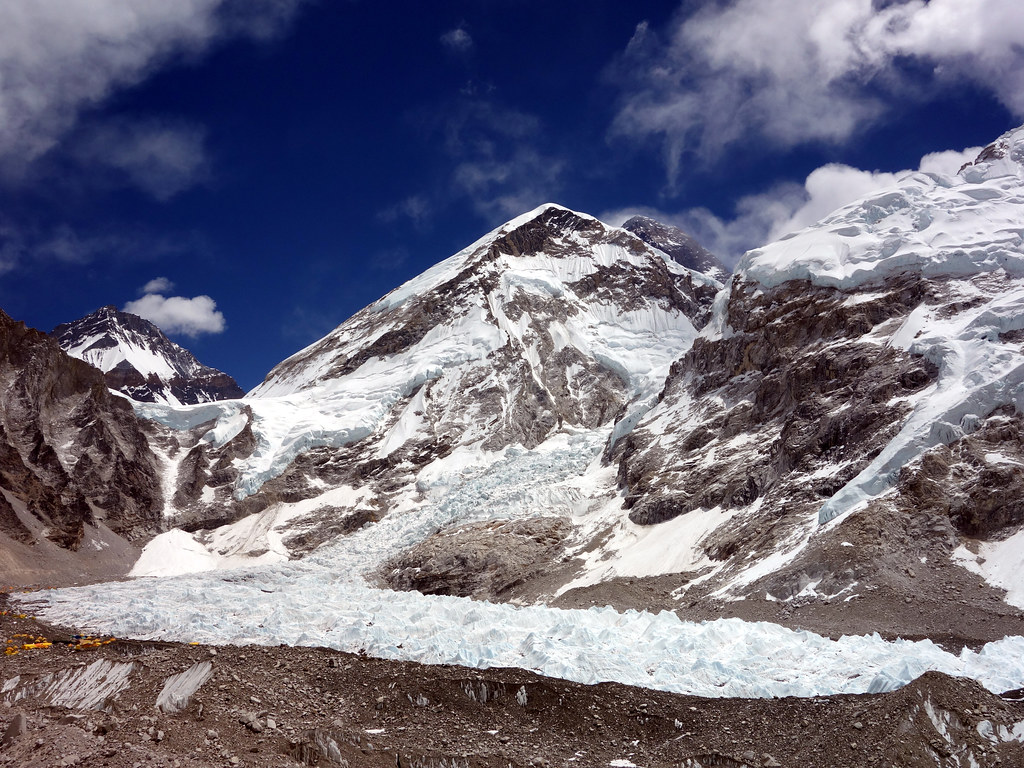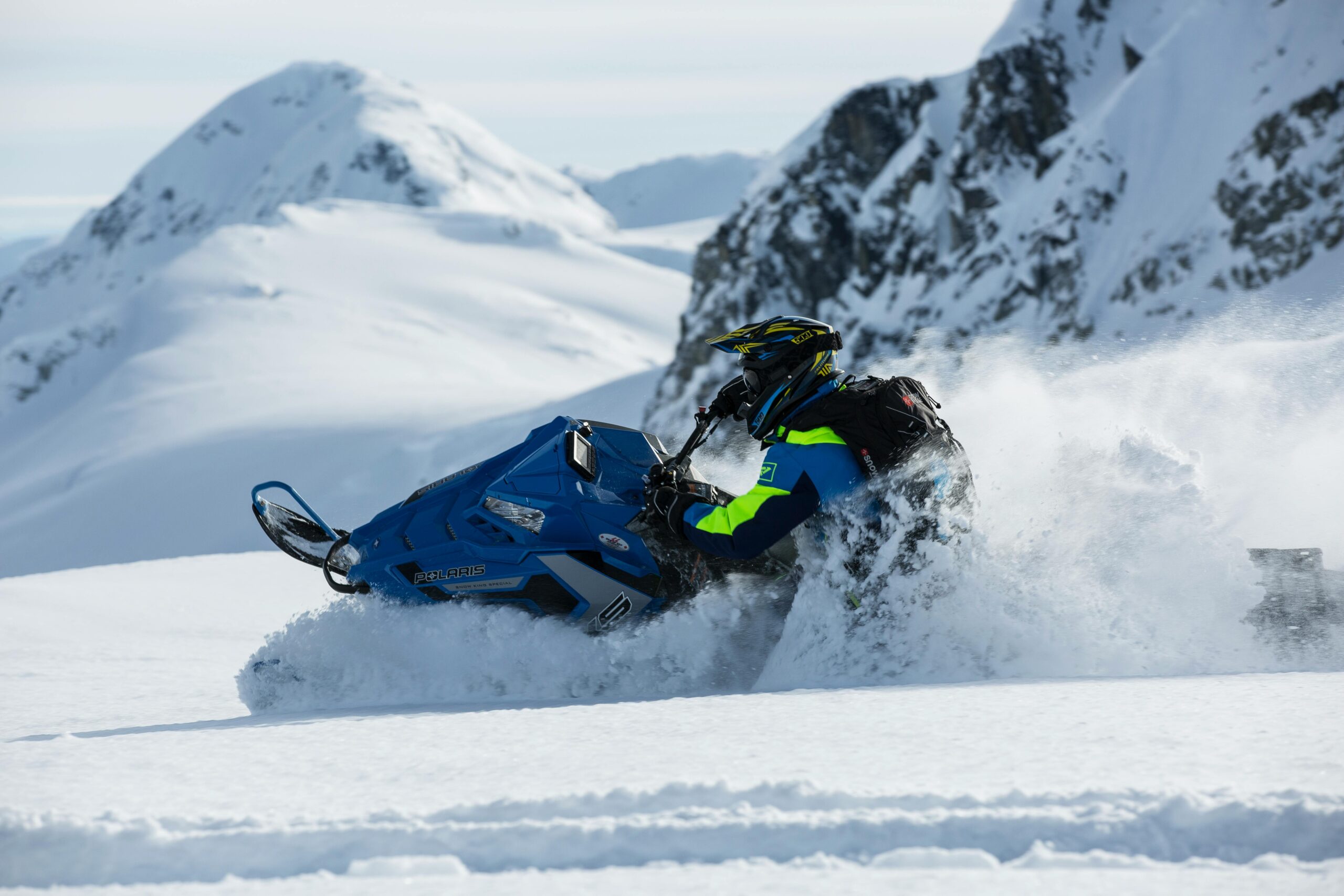Mount Everest. The very name conjures images of pristine snow peaks, adventurous souls, and the ultimate test of human endurance. At the heart of this towering dream lies the Khumbu Icefall, a formidable gateway to the summit’s splendors. This icefall, with its ever-shifting maze of crevasses and towering seracs, stands as a testament to nature’s raw power and unpredictability.
The Khumbu Icefall is renowned not just for its breathtaking beauty but also for the dangers it presents. Trekkers and climbers face a unique set of challenges when navigating this icy labyrinth. The icefall is an ever-changing beast, with crevasses opening and ice towers collapsing without warning. It’s a place where the ground beneath your feet can betray you at any moment, turning an adventure into a fight for survival.
The purpose of this article is to shine a light on the inherent dangers of the Khumbu Icefall. We aim to equip you, the intrepid trekker, with the knowledge needed to safely cross this natural obstacle. Preparation, awareness, and respect for the mountains might be your best tools on this journey. Through understanding the risks and adopting a meticulous approach to planning and execution, you can navigate the icefall’s hazards and embrace the awe-inspiring beauty of Everest with confidence.
Understanding the Khumbu Icefall
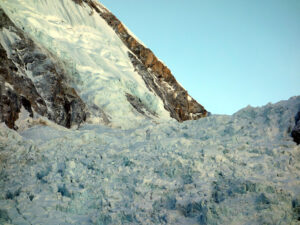
The Khumbu Icefall is a pivotal section of the journey for climbers aiming to conquer Mount Everest. This part of the climb, located at the head of the Khumbu Glacier, serves as a dramatic and challenging gateway to the higher reaches of the mountain. Understanding its geography, formation, and ever-changing landscape is crucial for any climber or trekker preparing to face its dangers.
Geographical Location & Formation
The Khumbu Icefall sits at the edge of the Khumbu Glacier, near Everest Base Camp on the Nepalese side of the mountain. This icefall is essentially the glacier in motion, cascading down from the Western Cwm to the valley below. As the glacier moves, it cracks and shifts, creating the icefall’s complex and dangerous terrain.
Glaciers move because of gravity, sliding over the bedrock beneath them. The movement is not uniform; it varies with the slope, the thickness of the ice, and the temperature, among other factors. When the glacier’s steep descent meets the flatter valley, the ice fractures, leading to the formation of the icefall. This process is continual, meaning the icefall is always changing, with new crevasses and ice towers forming as others vanish.
Composition & Landscape
The landscape of the Khumbu Icefall is one of extreme variability and danger. It comprises several key features:
Crevasses: These are deep cracks in the glacier that can be hidden by snow. Their width and depth can vary dramatically, with some being large enough to swallow an entire climbing team.
Ice Towers (Seracs): These are large blocks of ice that can stand as tall as houses. They form as the glacier moves and can be unstable, sometimes collapsing without warning.
Ladders: To navigate the icefall, climbers use aluminum ladders to cross crevasses and climb ice walls. These ladders are fixed in place by the Sherpas and can span several meters.
The terrain within the Khumbu Icefall is notoriously unpredictable. The glacier’s movement causes constant change; what might be a solid path one day could be a gaping crevasse the next. This unpredictability adds a significant risk to traversing the icefall, as climbers must be prepared to face new obstacles at every turn.
The Khumbu Icefall’s dynamic and perilous nature cannot be overstated. Every climber who attempts to cross it must be aware of its challenges and ready to adapt to its ever-changing landscape. The key to a successful crossing lies in preparation, caution, and respect for the mountain’s power.
Dangers of Crossing the Khumbu Icefall
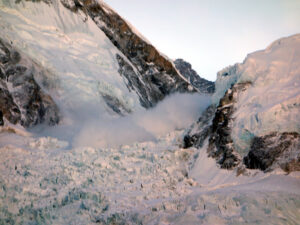
The Khumbu Icefall, a dramatic and unpredictable section of the route to Mount Everest’s summit, presents a series of dangers that climbers must navigate with extreme caution. The combination of its complex terrain, unpredictable weather, and the constant movement of the glacier creates a high-risk environment. Understanding these hazards is crucial for anyone preparing to face the icefall.
Avalanche Risks
The icefall’s constant motion creates unstable conditions that are prone to avalanches. This instability is due to the shifting ice and the steep inclines found within the icefall. Avalanches can occur with little warning, sending tons of ice and snow cascading down the mountain. These can be triggered naturally or by climbers themselves as they make their way across the icefall. The dangers of falling ice and debris from avalanches include severe injuries or even fatalities. Climbers must remain vigilant and move quickly through areas known to be particularly avalanche-prone.
Crevasses & Falls
One of the most insidious dangers within the Khumbu Icefall are the crevasses. These deep fissures in the ice can be hidden by thin layers of snow, known as snow bridges, making them difficult to spot. Falling into a crevasse can result in serious injuries, including broken bones or deeper trauma. The risk is compounded by the difficulty of rescue within the icefall, where every second counts.
Serac Collapse
Seracs, towering blocks of ice that can reach the size of buildings, dot the landscape of the Khumbu Icefall. These ice towers can collapse without warning due to the glacier’s movement, posing a significant threat to climbers. A collapsing serac can unleash a massive amount of ice and snow, with the potential to cause serious injuries or fatalities to those caught beneath. The unpredictable nature of these collapses makes them one of the most feared hazards in the icefall.
Weather Conditions
The weather on Mount Everest is notoriously fickle, and changes can happen rapidly, exacerbating existing dangers in the Khumbu Icefall. Avalanches and ice collapses are more likely to occur during periods of bad weather, particularly when there is heavy snowfall. Additionally, climbers face an increased risk of hypothermia from windchill at high altitudes. Wind and sudden temperature drops can make the crossing even more perilous, requiring climbers to be well-prepared and to carry suitable equipment to protect against the cold.
Navigating the Khumbu Icefall requires a combination of skill, preparation, and respect for the mountain’s power. Understanding these dangers and planning accordingly can help climbers mitigate the risks as they pursue their goal of reaching the summit of Mount Everest.
Preparing for a Safe Crossing
Navigating the Khumbu Icefall is one of the most daunting aspects of climbing Mount Everest. This section requires meticulous preparation and unwavering attention to safety protocols. From choosing the right guide to ensuring you have the appropriate gear, every decision plays a critical role in ensuring a safe crossing.
Importance of a Qualified Guide
The first step in preparing for the Khumbu Icefall is securing a guide who is not only certified but also has extensive experience with this specific section of Everest. These guides are invaluable because they:
Navigate Safely: They know how to find the safest routes through the constantly changing landscape of the icefall.
Identify Hazards: Their experience allows them to spot potential dangers, such as weak snow bridges or unstable seracs, which might not be apparent to less experienced climbers.
A seasoned guide is your most crucial asset in the icefall. They provide not just a path forward but also the wisdom to avoid the myriad dangers hidden within the ice.
Training & Fitness Level
The physical demands of crossing the Khumbu Icefall cannot be overstated. Proper physical conditioning is essential, and climbers should:
Focus on Cardiovascular Fitness: To aid in stamina and acclimatization.
Strengthen Core and Legs: For the rigors of climbing and navigating uneven terrain.
Practice with Gear: To ensure comfort and familiarity with the equipment in challenging conditions.
An appropriate training routine might include long-distance hiking, weight training, and exercises that simulate high-altitude conditions as much as possible.
Equipment & Clothing
Equipping yourself with the right gear and clothing is vital for a successful crossing. Essential items include:
Crampons for traction on the ice.
Ice Axe for stability and safety.
Harness for roped travel through dangerous sections.
Proper Footwear designed for cold-weather climbing.
Clothing should be layered for insulation, with materials that provide warmth even when wet, and outer layers that protect against wind and moisture.
Following Safety Procedures
Adhering to established safety protocols is crucial for minimizing risks. Key practices include:
Crossing at Optimal Times: Early morning crossings minimize the risk of avalanches and serac collapses, which are more common under the midday sun.
Using Fixed Ropes and Ladders: These are placed by experienced Sherpas and should always be used where available to navigate crevasses and vertical ice walls.
Listening to your guide and following their instructions without deviation is perhaps the most important safety measure of all. Their expertise and instructions are your lifeline in the unpredictable and dangerous terrain of the Khumbu Icefall.
By taking these preparatory steps seriously—choosing the right guide, conditioning your body, equipping yourself with the necessary gear, and strictly adhering to safety protocols—you maximize your chances of a safe and successful crossing of the Khumbu Icefall.
Conclusion
The Khumbu Icefall is a formidable barrier on the path to Mount Everest’s summit, presenting a series of significant dangers to climbers. Avalanches, hidden crevasses, unpredictable serac collapses, and rapidly changing weather conditions are just a few of the perils that make this section of the climb particularly treacherous. Navigating it requires more than just courage; it demands meticulous preparation, physical readiness, and an unwavering respect for the mountain’s might.
The importance of planning and preparation cannot be overstated. From engaging a qualified guide with specific experience in the Khumbu Icefall, to undergoing rigorous physical training, and equipping oneself with the necessary gear and clothing, every step in the preparation process is vital. These measures, combined with strict adherence to safety protocols and a willingness to heed the advice of experienced guides, are key to minimizing the risks inherent in crossing the icefall.
Ultimately, the Khumbu Icefall is a powerful reminder of nature’s unpredictability and the need for humility in the face of such formidable challenges. It demands respect and a cautious approach from all who attempt to traverse its icy expanse. By acknowledging its dangers and taking comprehensive steps to mitigate them, climbers can enhance their chances of safely enjoying one of the most awe-inspiring experiences on the planet.

